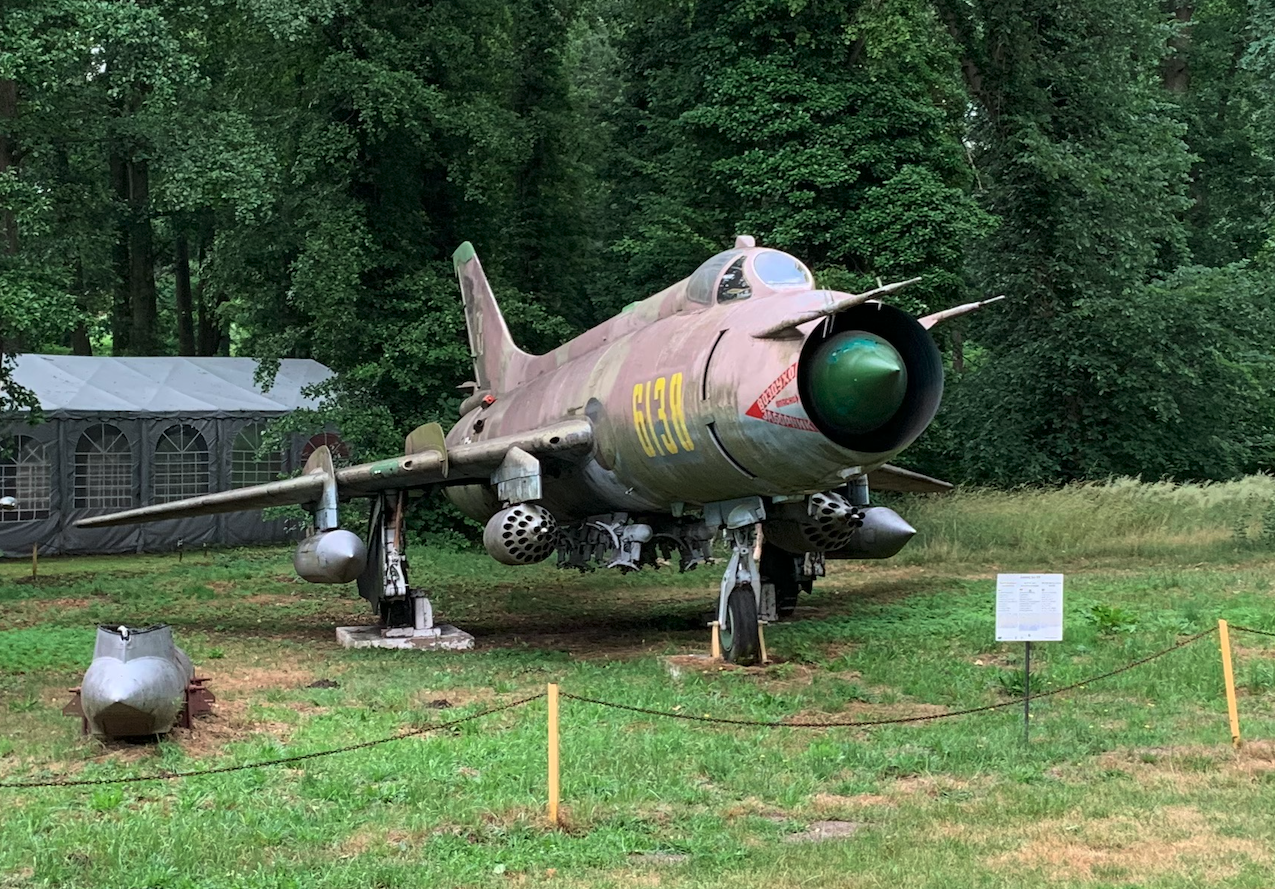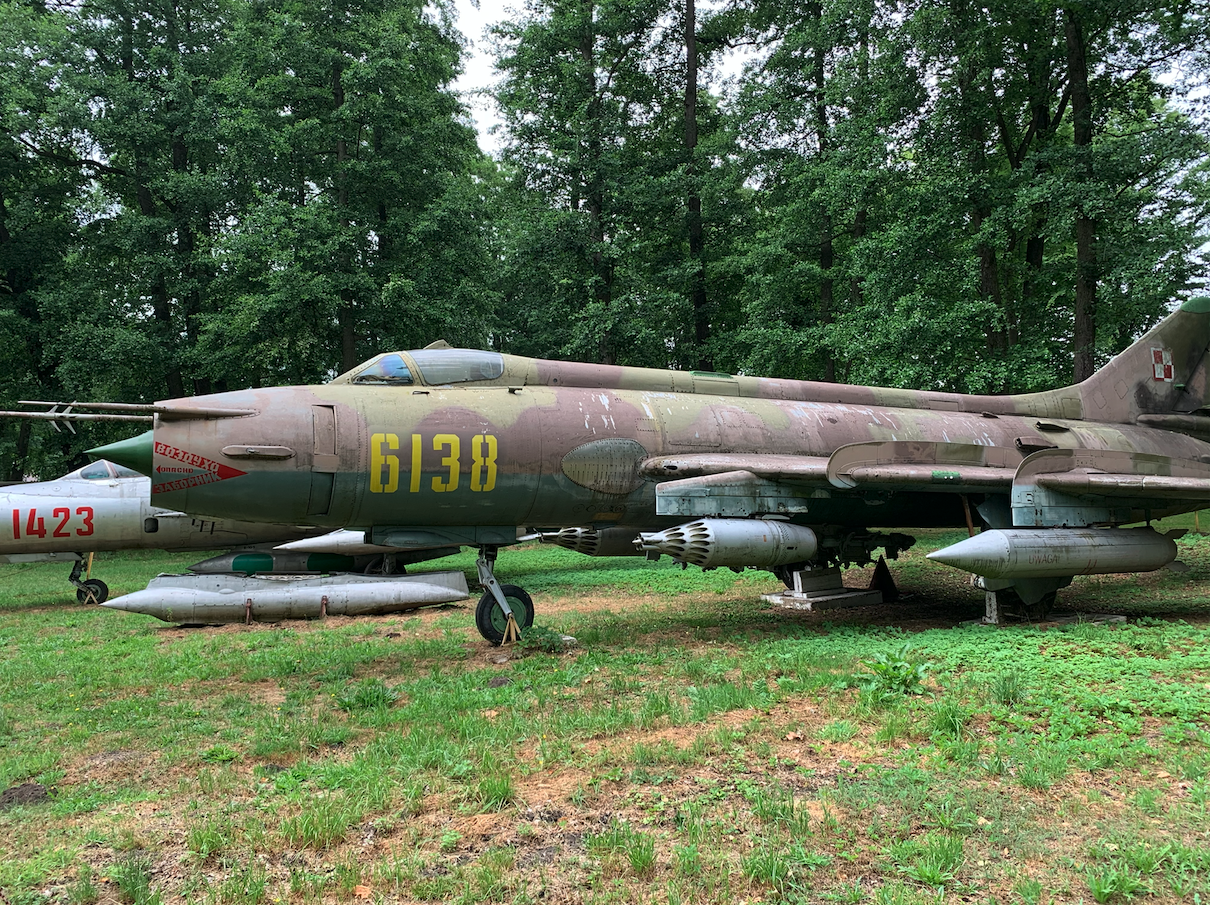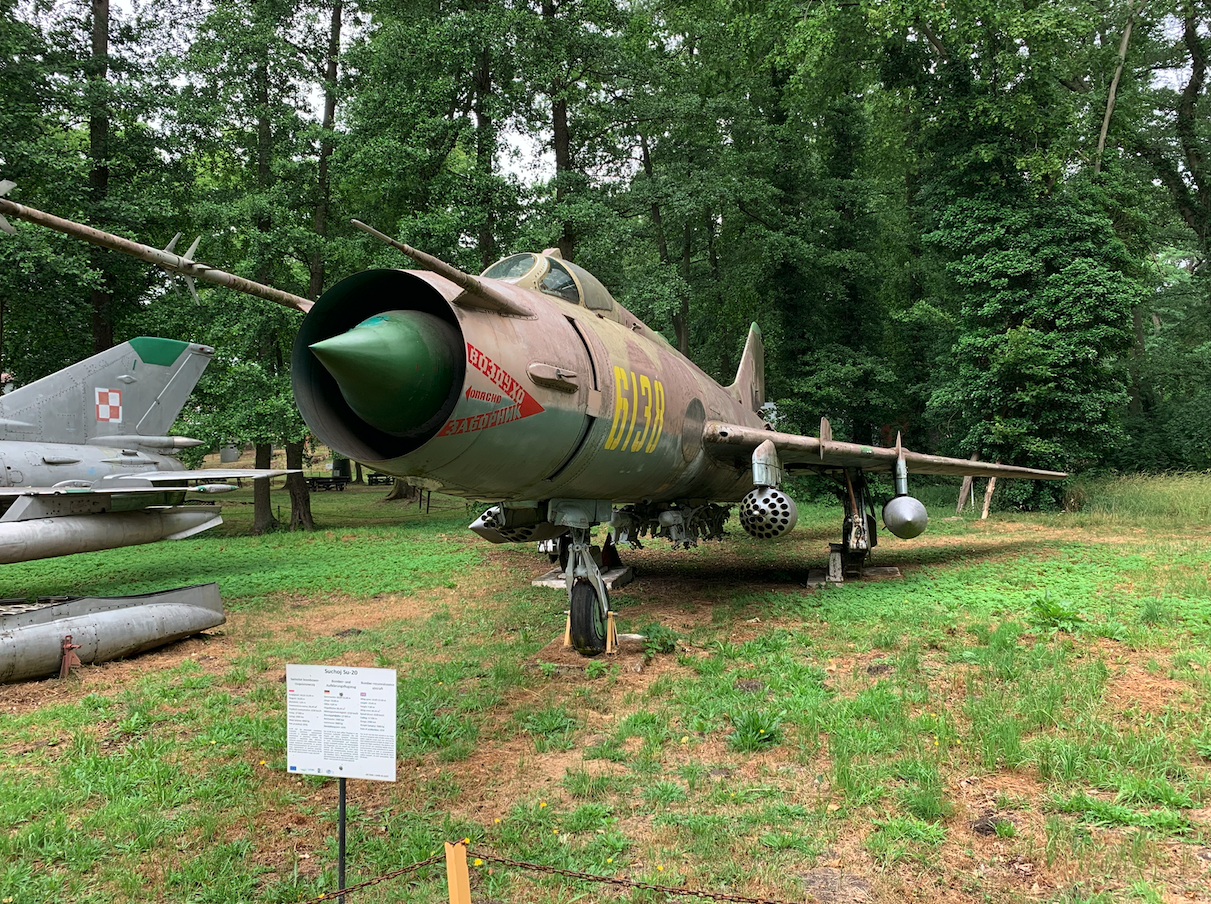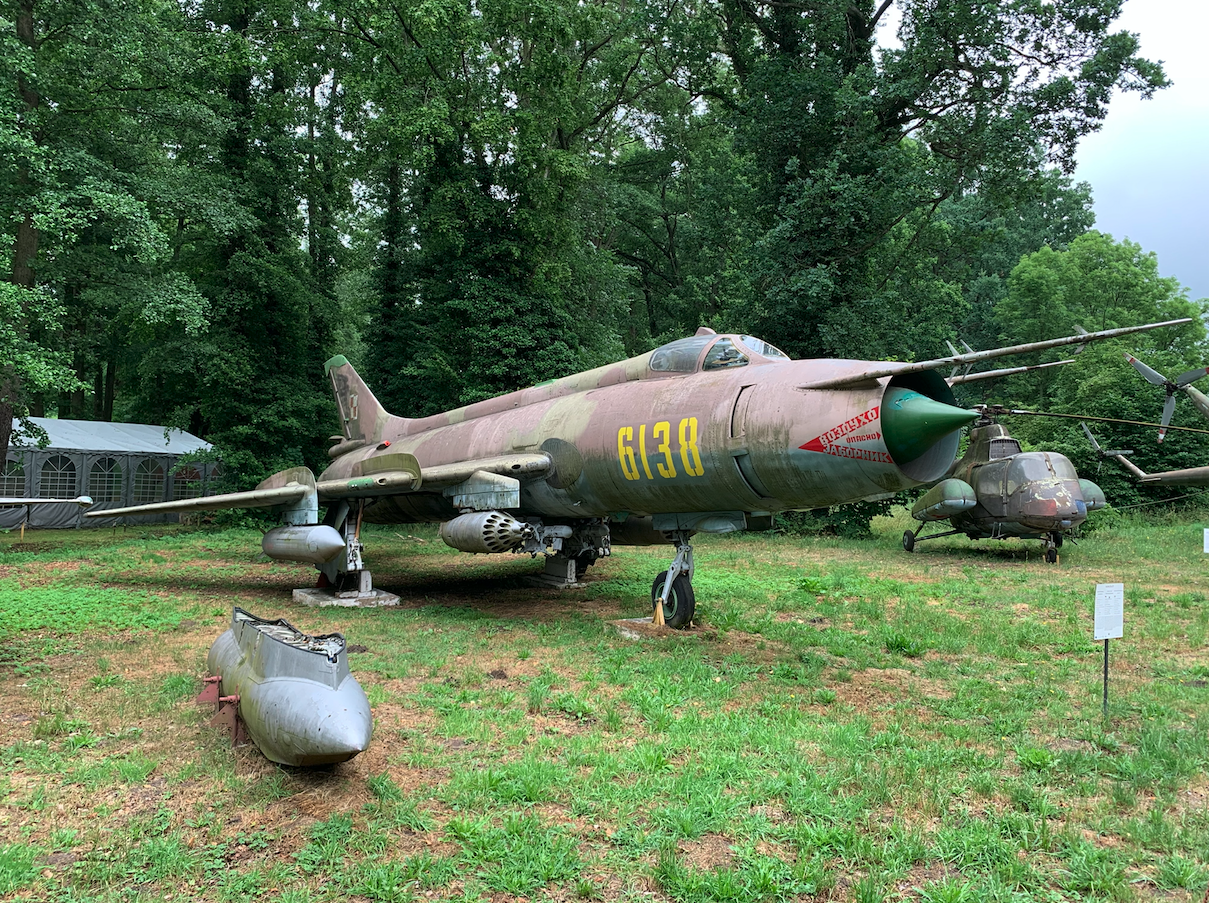Drzonów 2022-08-11
OKB Sukhoi Su-20 nb 6138 serial number 74728.
Supersonic fighter-bomber with variable wing geometry. The first plane of this type in the Polish Army.




Su-20 (Su-17 MK). 1972 year.
In February 1972, an export variant of the Su-17 M aircraft, designated Su-17 MK (Kommerczieskij), was ordered. The prototype took off on December 15, 1972, piloted by A. Isakow. In the period of January-December 1973, the aircraft successfully passed state tests and was put into mass production. The first deliveries to the Middle East arrived in the first months of 1973, as the war, later called the "October" war, was fast approaching. Production was carried out in the years 1972-1976 and covered the number of 136 units in the series "62-66 and 74-76". The planes were exported to Egypt, Iraq, Poland and Syria.
The Delta-N radio-command equipment has disappeared from the aircraft cone, and a SRD-5 MK radio rangefinder has been installed in its place, which can work with infrared guided missiles, class p-p R-3 / R-13, up to 4 pieces on the beams under the wings of APU-13 M. The Delta-NG apparatus itself was placed in the nacelle under the right inner node. UPK-23-250 shooting gondolas with GSz-23 cannons with a supply of 250 rounds appeared in the armament. Ch-28 guided missiles and S-8 and S-25 unguided missiles were completely excluded from the armament.
Combat use of the Su-17, Su-20.
The combat use of Su-17 and Su-20 aircraft was significantly limited by weather conditions. A lower cloud base or poor visibility with a very simple navigation system often made it impossible to complete the task. Su-17 planes, up to and including Su-17 MK, could be brought into the target area with some approximation, but its search and attack had to be performed by the pilot in conditions of visual visibility.
Reconnaissance aircraft Su-20 R.
In the mid-1970s, the KKR-1 reconnaissance containers (kontejner Kompleksnoj razwiedki) were introduced for the Su-20 (export) aircraft. The tray has dimensions; length 6.79 m, width 0.59 m, height 0.58 m, and with a beam 0.715 m, weight 780 kg. The hopper is moved centrally under the fuselage.
The container enables vertical, perspective and panoramic shooting of the terrain from low and medium altitudes in daytime conditions and from low altitudes in night conditions as well as general radio-electronic reconnaissance from any altitude, at any time of the day or night in "all weather conditions".
It consists of; AFA-39 camera (for vertical and perspective shots), PA-1 (panoramic), UA-47 (vertical at night), SFP-2 A flash cartridge ejector, 4 KDF-38 cartridges with FP-100 flash cartridges, block delay BZ pulses used to generate signals to open the shutter of the UA-47, SRS-9 Wiraż electronic reconnaissance stations, freon cooling system.
The Su-20 R plane with the KKR-1 container has a take-off weight of 15 610 kg, the maximum speed, depending on the flight altitude, is 1,300 - 1,800 km / h. Range at an altitude of 200 m - 735 km or with two PTB-1 tanks 150 - 1,150 km. And the range at an altitude of 10,000 m is 1,400 km and 2,050 km respectively. The permissible overload of the aircraft in flight is 5g. In the Polish Army, the KKR-1 container was later installed on Su-22 aircraft.
History of purchase of Su-20 aircraft for Poland.
At the beginning of the 70s of the twentieth century, Polish politicians and military began looking for a replacement for the Il-28 bombers. The last 6 Ił-28 bombers were removed from the state in 1979, but they did not have any combat value for the entire decade. CCCP offered Poland MiG-23 BN or Su-20 planes. Both planes with variable wing geometry. The offers were analyzed in terms of their usefulness in the Polish Aviation. According to Polish specialists, none of the offered planes met our requirements. But there was no other alternative. The choice fell on the Su-20 aircraft, as a cheaper machine and largely similar to the Su-7 aircraft of various varieties already used in Poland.
Deliveries of Su-20 to Poland.
In the first days of 1974, a group of pilots and technicians left Poland to train for a new type of aircraft. The pilots included: Major pilot Maciej Paszkowski - commander of the 7th Bomber and Reconnaissance Regiment from Powidz in 1974-1975, second lieutenant pilot Bogdan Lis, captain Tadeusz Kołodziejczyk and others. They were the first to make independent flights on Su-20 planes in Krasnodar. Due to bad weather conditions, the training took a long time. During this training, during the flight on the Su-20, Capt. pil. Tadeusz Kołodziejczyk. Honor his memory!
The first 6 Su-20s were delivered to Poland in 1974. On April 26, 1974, the planes landed at the airport in Powidz. These planes were given side numbers from 01 to 06, painted red. The planes were shown in flight during a parade in Warsaw on July 22, 1974. The remaining planes were not delivered until 1976. A total of 25 copies were purchased. The training and combat version was not purchased, as Su-7 U planes were still used in this role.
Unfortunately, even before the main delivery was made, on February 3, 1976, the first Su-20 aircraft was lost. The plane had the side number 01. If the plane had survived the changes to the side numbers, it would have received nb 4241. The loss was painful because another aviator, Major (Cpt.) Pil. Jerzy Doliniec. Honor his memory! The catastrophe took place near the town of Kazimierz Biskupi. The reason was a technical fault in the equipment. The engine has failed and it has stopped running. In addition, the entire power supply failed and there were problems with the aggregates. The failure was the fault of the manufacturer who found himself to be guilty. Therefore, in place of the lost plane, the manufacturer supplied a new plane (1977). The plane was delivered on 02/12/1977. The plane received nb 7125.
The remaining 19 Su-20s were delivered in the summer of 1976. These airplanes received four-digit side numbers derived from the serial numbers, painted in red. At that time, the side numbers of the first 6 machines were also changed.
Using the Su-20 in Poland.
In Poland, Su-20 planes have become dual-purpose machines. On the one hand, they could effectively attack enemy objects in the background, and on the other hand, they could conduct active photo and radio-electronic reconnaissance during the day and at night. This is the second task with the use of a KKR-1 type suspended tray. The containers arrived in Poland later. It should not be forgotten that the Su-20 used in Poland was also a potential carrier of tactical nuclear weapons.
The Su-20 planes took part in their first joint exercises in 1976, during maneuvers under the code name "Shield-76". The Su-20 planes were also operated with DOL (road airport sections) throughout their service in Poland.
In the 80s, three times Polish pilots saved Su-20 planes from crashing, risking their own lives. On May 18, 1984, Captain Andrzej Pawul collided with a stork during the flight. The pilot suffered a face injury from glass shards and limited visibility. However, the pilot managed to land safely. On September 4, 1985, Captain Krzysztof Ryniecki. After firing the S-24 heavy missile, engine pumping occurred and the engine went out. Despite the low flight altitude, the pilot managed to restart the engine and land safely at the airport. In 1988, the Su-20 plane with the pilot Major Krzysztof Krzysztoforski was hit by lightning. The engine stopped. The pilot restarted the engine and landed safely at the airport.
Information from 1990-10-16, from the Su-20 and Su-22 aircraft show for Swedish officers. - Su-20 used in Poland have excellent landing parameters. Captain Bogdan Juczyk is the master of the short landing. Before the touchdown, at a height of 2 m, the pilot releases the braking parachute. The measured landfall distance is only 350 m! At that time, the American tests of the F-15 S / MTD aircraft gave a result of 450 m, without a braking parachute, and 380 m with the method used in Poland. The landing weight of the Su-20 aircraft is 11,000 kg, and of the F-15 S / MTD aircraft - 13,000 kg.
Sukhoi Su-20 nb 6138 serial number 74728.
The Su-20 nb 6138 aircraft serial number 74728 was built in December 1975. The plane was delivered on March 18, 1976. The plane was used in the 7th PLB-R in Powidz. Decommissioned on February 28, 1997. In October 1999, the plane was handed over to the museum in Drzonowo, near Zielona Góra.
Written by Karol Placha Hetman
